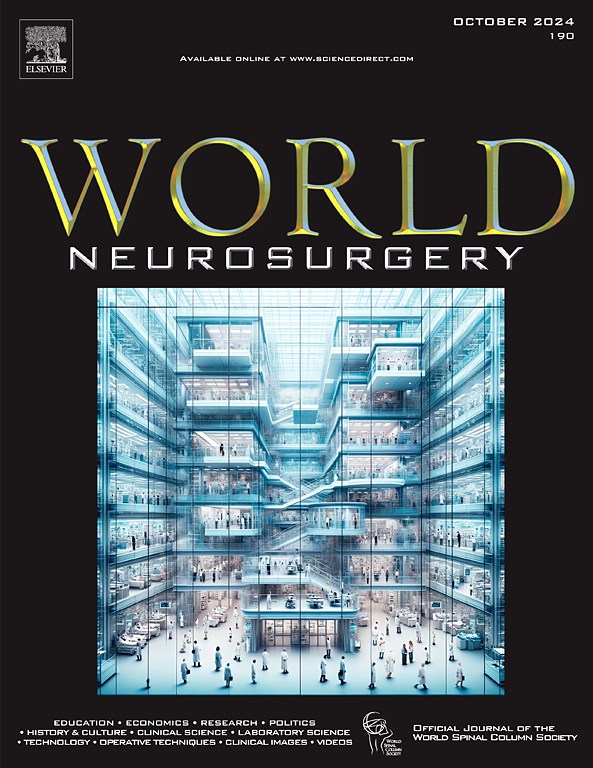Surgical Strategy for Superior Cerebellar Peduncle Lesions: Utility of the Subtemporal Transtentorial Approach
IF 2.1
4区 医学
Q3 CLINICAL NEUROLOGY
引用次数: 0
Abstract
Background
Tumors involving the superior cerebellar peduncle (SCP) are rare and pose considerable surgical challenges due to their deep and complex location. While the supracerebellar infratentorial approach has been the most frequently described strategy, it may be insufficient for lesions extending along the entire SCP. We present 2 cases of SCP tumors to highlight the utility of the subtemporal transtentorial approach.
Methods
Case 1 was a 28-year-old woman with a hemorrhagic SCP tumor extending into the fourth ventricle. Resection was performed in 2 stages using the trans-cerebellomedullary fissure and occipital transtentorial approaches, but the central SCP remained inaccessible. In case 2, a 33-year-old man with an enlarging lesion encompassing nearly the entire SCP underwent surgery. Based on simulation and prior experience, the subtemporal transtentorial approach was selected for its potential to provide a panoramic view of the SCP.
Results
In case 1, volumetric analysis demonstrated a resection rate of 90.1% achieved through staged approaches, with no postoperative neurological deficits. The Karnofsky Performance Status score remained at 90 at 21 months after surgery. Pathology confirmed pilocytic astrocytoma. In case 2, the subtemporal transtentorial approach enabled 79.0% resection while preserving cerebellar and cranial nerve function, with a Karnofsky Performance Status score of 100 at 18 months. Pathology revealed dysplastic cerebellar gangliocytoma (Lhermitte-Duclos disease).
Conclusions
The subtemporal transtentorial approach offers a direct and linear trajectory to lesions extending along the entire SCP, allowing substantial resection while minimizing functional morbidity. Although experience remains limited, this approach should be considered for surgical access to the SCP.
小脑上脚病变的手术策略:颞下经小脑幕入路的应用。
背景:累及小脑上足部(SCP)的肿瘤是罕见的,由于其位置深而复杂,给手术带来了相当大的挑战。虽然小脑上幕下入路是最常被描述的策略,但它可能不足以治疗沿整个SCP延伸的病变。我们报告了两例SCP肿瘤,以强调颞下经额叶入路的实用性。方法:病例1为一28岁女性,SCP出血性肿瘤延伸至第四脑室。手术分两个阶段进行,分别采用经小脑髓裂和枕部经脑幕入路,但仍无法进入中央SCP。在病例2中,一名33岁的男性因几乎整个SCP的病变扩大而接受手术。基于模拟和先前的经验,我们选择了颞下经额叶入路,因为它有可能提供SCP的全景视图。结果:在病例1中,体积分析表明,通过分阶段入路切除率为90.1%,术后无神经功能缺损。术后21个月Karnofsky Performance Status (KPS)评分为90分。病理证实为毛细胞星形细胞瘤。在病例2中,颞下经额叶入路在保留小脑和脑神经功能的同时,实现了79.0%的切除,18个月时KPS评分为100。病理表现为发育不良的小脑神经节细胞瘤(Lhermitte-Duclos病)。结论:颞下经额叶入路提供了沿整个SCP延伸的直接和线性的病变轨迹,允许大量切除,同时最大限度地减少功能并发症。虽然经验仍然有限,但这种入路应该被考虑用于手术进入SCP。
本文章由计算机程序翻译,如有差异,请以英文原文为准。
求助全文
约1分钟内获得全文
求助全文
来源期刊

World neurosurgery
CLINICAL NEUROLOGY-SURGERY
CiteScore
3.90
自引率
15.00%
发文量
1765
审稿时长
47 days
期刊介绍:
World Neurosurgery has an open access mirror journal World Neurosurgery: X, sharing the same aims and scope, editorial team, submission system and rigorous peer review.
The journal''s mission is to:
-To provide a first-class international forum and a 2-way conduit for dialogue that is relevant to neurosurgeons and providers who care for neurosurgery patients. The categories of the exchanged information include clinical and basic science, as well as global information that provide social, political, educational, economic, cultural or societal insights and knowledge that are of significance and relevance to worldwide neurosurgery patient care.
-To act as a primary intellectual catalyst for the stimulation of creativity, the creation of new knowledge, and the enhancement of quality neurosurgical care worldwide.
-To provide a forum for communication that enriches the lives of all neurosurgeons and their colleagues; and, in so doing, enriches the lives of their patients.
Topics to be addressed in World Neurosurgery include: EDUCATION, ECONOMICS, RESEARCH, POLITICS, HISTORY, CULTURE, CLINICAL SCIENCE, LABORATORY SCIENCE, TECHNOLOGY, OPERATIVE TECHNIQUES, CLINICAL IMAGES, VIDEOS
 求助内容:
求助内容: 应助结果提醒方式:
应助结果提醒方式:


